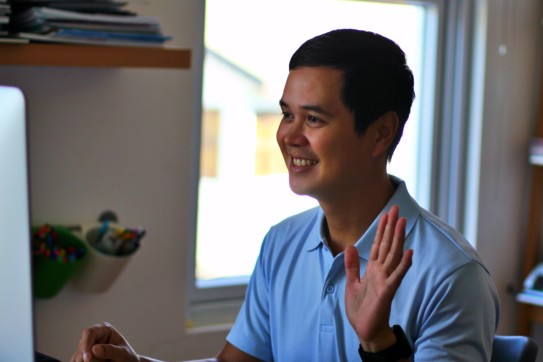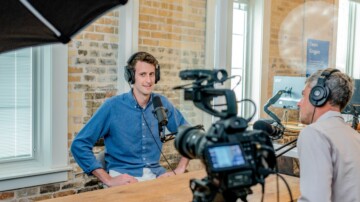10 Tips for Using Zoom for Successful Donor Visits

I feel grateful.
Maybe, lucky?
I’m not sure which word is more correct for such a tumultuous and devastating situation. Neither seems entirely accurate.
I have been a remote Vice President for Advancement for almost five years. I raise funds for Starr King School for the Ministry, located in Berkeley, California. By contrast, I live and work from my home office in Hattiesburg, Mississippi.
Our school has been doing distance-learning before it was cool or necessary (since 2001). We maintain both high residency and low residency program options, with regular in-person courses, twice yearly intensive courses, and online coursework too.
This long-term embracing of technology has prepared both students and employees to work from home, and has also allowed the school to hire folks (like me) without requiring them to move to the Bay Area (which of course has an outrageous cost of living).
I say all of this because I understand that so many of my colleagues are struggling right now. You’re struggling to establish a functional home office. You may be struggling to understand why it seems that leadership didn’t prepare for these eventualities. You’re worried about your elders, your kids and other loved ones (and yourselves). You’re worried about metrics and how you’ll be held accountable for this time at home.
You’re also getting used to Zoom and other video conferencing technologies, but you know that using it for a morning check-in with your team is very different than using it for a donor call.
Zoom has been a big part of my life for several years now and I’ve used it for board meetings, staff meetings, and committee meetings. But I hadn’t used it for very many donor calls… until I was told not to travel anymore.
Starr King closed our building on March 9, 2020. My last trip was to Boston and I returned home on March 12. I decided that day I would throw myself into using Zoom to connect to my donors. We finished a feasibility study in the fall and we needed to follow-up with all participants to clarify and confirm their campaign gift intentions. The first week I had six donor visits and got $2.7 million in verbal commitments. Now, granted $2 million of that was asked for in-person the week prior, but $700,000 is still a great week’s work in my book.
How is using Zoom for donor meetings different? Has use of video conferencing led to any new best practices? I thought about my experience the last few weeks and my long experience using Zoom and I decided to organize my thoughts for you to start the conversation about using Zoom to meet with donors.
Here are my 10 best practices for conducting a Zoom meeting with donors:
1. Consider Zoom equivalent to an in-person meeting.
I’m talking to the managers right now. There is very little substantial difference between a video chat and an in-person visit. You can read body language and tone inflection. You get to see some of their home. You learn about their philanthropic priorities. You build a stronger bond than on the phone. This work should count for metrics. In fact, lengthy phone calls that move the relationship forward should count as visits now. At a time when you can’t even visit friends and family in person, people are becoming more accustomed to connecting digitally. Stop worrying about the numbers so much and just make sure your folks feel supported and empowered to move donor relationships forward in whatever ways make sense right now.
2. Lead with care for your donor.
Lead with concern and care for your donor, from the emails you send to get the visit to the first things you say to them on the Zoom call. Anyone going out there during this crisis with a “rah-rah” salesperson attitude will rightly get crushed. Your first question on your call should 100% be: “How are you and your family? Are you all well?”
3. Then, express the priorities of your organization.
Next, express clearly the priorities of your organization. Spoiler alert: The top priority of your organization right now should be the health and welfare of those you serve and the employees. So, if you are a school, your top priority should be the health and welfare of students, faculty, and staff. Remember, you might talk about your personal life a bit but your job is not to talk about you. Your job is to bring your donors closer to the organization you represent.
Tip Sheet: Ideas for Gift Officer Communication During a Crisis
4. Log-on 5 minutes early.
One of my old bosses told me, “On time is not on time. Early is on time.” And that goes for video conferences and conferences calls too. Get on Zoom 5-10 minutes before the appointed time and you can mute yourself and turn your video off. That way you can feel relaxed and maybe answer an email or two before the donor logs on. You’ll hear a doorbell style beep when they join the meeting and then you can unmute and turn video back on to greet them.
5. Don’t freak out if your kids (or pets) walk in.
Until this past August, we homeschooled my two kids while I worked from home. (So, weirdly, we are returning to that situation again.) Everyone I work with has met my kids because they have frequently interrupted meetings. Don’t freak out. Not only will it make you look like a heartless crazy person, but it will damage your relationship with your kids. (Same goes for pets.) Invite them to introduce themselves, handle their issue, and calmly set boundaries, asking them to leave the room.
In terms of preparation, if you have a spouse or partner at home, letting them know when you’ll need privacy for a call is helpful. If you are on your own, set children up in a nearby room with something quiet (like LEGOs) and Netflix. Do not worry about using screen-time to get quiet so you can do these visits. That’s a legitimate use of television. Pets can go in another room or out in a secure yard for a little while if necessary.
6. Yes, you can do discovery visits during this crisis (and via Zoom).
I’ve had donors who live in areas where I haven’t had time to travel yet who have accepted Zoom calls in the last few weeks. Now is the time to use this technology. Folks are using it to attend church, hang out with friends and talk to family. It’s been demystified for your donors. Many will take a visit on Zoom now that wouldn’t have before.
Note: a few of my donors still requested to use the phone only. I gladly accommodated that. After being on Zoom for several hours a day, a phone call was a nice reprieve.
7. Try doing a week on and a week off.
After going hard with Zoom visits (and some phone calls) for three weeks, I was burnt out. It was grueling too to try to set up meetings in between doing the meetings. I had to take a week of vacation to recover. When I go back, I’m going to set up a system where I have one week “off” of Zoom visits, during which I use the time to set up visits for the next week. Then I have a week “on” where I will have a burst of meetings. In my view, the “on” weeks are like having a productive trip. You wouldn’t travel every single week, back to back. Don’t try to do it with Zoom either.
8. Avail yourself of all the general best practices for using Zoom.
There are lots of great articles going around about making yourself look your best on Zoom. Checking your background, having your camera properly placed, managing your lighting, all of these are important elements of having a great Zoom call.
9. Some donors are going to need more time. And that’s ok.
Right now, the markets are erratic and donors are rightly nervous. If you are asking about major gifts, you may need to wait to close the gift. I’ve had several donors tell me they would continue their annual support and were committed to making a campaign gift, but they would need more time to determine the exact size of their gift. We agreed to get on a schedule to check-in every 3-4 months to see how the market is recovering.
10. Have a follow-up step planned.
Especially for my discovery visits that I did those first few weeks, I wanted to have something else for them to look forward to, besides just talking with me again. The president of my institution agreed that she would happily co-host some small group sessions with 5-6 major donor prospects via Zoom. This will make good use of her time and mine. And it deepens our relationships with those donors in a very meaningful way.
BONUS TIP: It’s also worth noting that cutting out travel does save some budget dollars, which can be repurposed into other means of digital connection. If you are using the free version of Zoom with a limit of 40 minutes, you may want to consider repurposing some of your budget dollars to get the paid version of the software (or another web conferencing software). If you only use the meeting module now and you plan to convert a big event to digital only, consider upgrading to use Zoom webinars. The webinar module in Zoom is a great product for delivery of information with a larger group. If you are trying to hit your annual fund goals or raise money for relief, move a significant amount of resources into boosting posts on social media and running Facebook ads.
In conclusion, let’s all remember how privileged we are to have jobs that can be done from home. We are safe from the virus, helping to flatten the curve, and still getting paychecks, all while doing good work for our institutions. Let’s choose to view this time as one where we can innovate and connect in new ways. We must keep our donors near, dear and clear during this crisis. Technology can help you do that!



